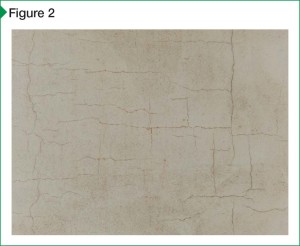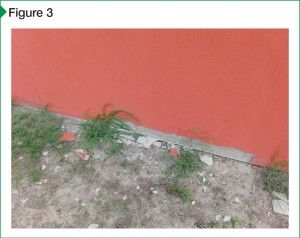
Providing an adequate substrate
The performance of any stucco application is controlled by the base coat. This consists of either a two-layer application of a scratch and brown coat or a single-layer base coat that performs both functions (called a ‘one-coat’ system, even though an additional finish coat is subsequently applied). The base coat is required to act as the primary cladding layer and the substrate for an architectural finish. Poor curing of the base coat can result in the system’s failure to perform these intended functions.
In a traditional three-coat stucco system, the finish coat must be cured using the same practices as base coats. Moist-curing can be terminated after 48 to 72 hours, but the finish coat should remain uncoated for at least seven days to prevent coating failure or poor bonding. It is not generally recommended to moist-cure proprietary finish coats with integral color, as this can cause discoloration. For proprietary finishing coats, follow the manufacturer’s recommendations.
Possible failures
Experience has shown a lack of curing can result in failures that develop quickly after construction (or before substantial completion). Other long-term consequences of not properly curing stucco—including shortened service life, corrosion of metal lath and accessories, and water penetration—are being researched.
Blistering
Blistering of the finish coating applied before full curing of plaster can occur, as shown in Figure 1. Stucco, when fresh, has a high pH level (i.e. more than 11), similar to concrete. As it cures, the pH level falls and the surface can accept a finish coating. If applied to uncured stucco, the finish coating can lose adhesion. This finish coat was applied before the base coat was fully cured, resulting in severe blistering (i.e. saponification) an acid-base reaction. Applying the finish coating early can also inhibit curing of stucco by limiting water absorption, resulting in a permanently soft stucco surface.

Widespread cracking associated with shrinkage
Shrinkage cracks occur when the plaster dries out quickly due to moisture evaporation within the mix. Shown in Figure 2, shrinkage is often accommodated with control joints at regular intervals, but in severe drying conditions, control joints are not enough to prevent cracking within the panels.
Delamination
Delamination (Figure 3) occurs in composite materials when two adjacent surfaces do not achieve an adequate mechanical or chemical bond to resist the stresses imposed. In stucco, this adhesion failure can occur at the plaster-to-substrate interface or between two layers of plaster. Bonding, both to the substrate and subsequent layers, is controlled by proper substrate preparation, application techniques, and the plaster’s sufficient strength gain. In this application, the plaster finish coat was applied before the base coat developed adequate strength, which is dependent on hydration.

Best practices
To enhance stucco durability, the best choice a designer can make is to specify, and enforce, proper curing in the contract documents. Simply referencing standards is not enough, because they conflict and are not typically stringent. Standards can also be vague and do not refer to the active process of adding water to the surface to prevent it from drying during the specified period. Relying on the weather conditions is not an acceptable curing method.
For example, Northwest Wall and Ceiling Bureau’s (NWCB’s) Stucco Resource Guide only suggests curing the first (i.e. scratch) coat for a minimum of 48 hours. Conversely, Texas Bureau of Lathing and Plastering’s (TBLP’s) Systems Manual does not require moist-curing when the humidity in the air is over 75 percent. Stucco manufacturers typically call for moist-curing stucco a minimum of 48 hours.
There are two widely accepted methods for curing stucco: surface-misting (or fogging) and the double-back method.
Surface-misting
The best curing method is surface-misting with water. This includes lightly misting the surface of each layer of plaster two to four times daily for 48 to 72 hours after application. The method can be easily modified—but not eliminated—to accommodate the weather conditions as needed. Portland Cement Association’s (PCA’s) Portland Cement Plaster/Stucco Manual suggests it is generally enough to fog the surface with water at the workday’s beginning and end. The water should be applied as a mist or fog, avoiding over-saturating the plaster; a heavy stream of water could damage the plaster if enough strength has not been developed. Cold water applied to hot stucco can also cause distress from thermal shock.





Great article!
To the point and information filled; with actual practical advice applicable to the field.
I recently had a thin layer of new stucco put on my house to add texture. I have been wetting it for two days now and the stucco is turning white in areas. IS this normal? Is this efflorescence? I was under the impression that efflorescence was bad. Can I paint over it or do I need to remove the efflorescence first?
I just had my house stuccoed. They didn’t most it down and some areas look rusty! Is that common for New Mexico weather. It was 89 degrees outside.